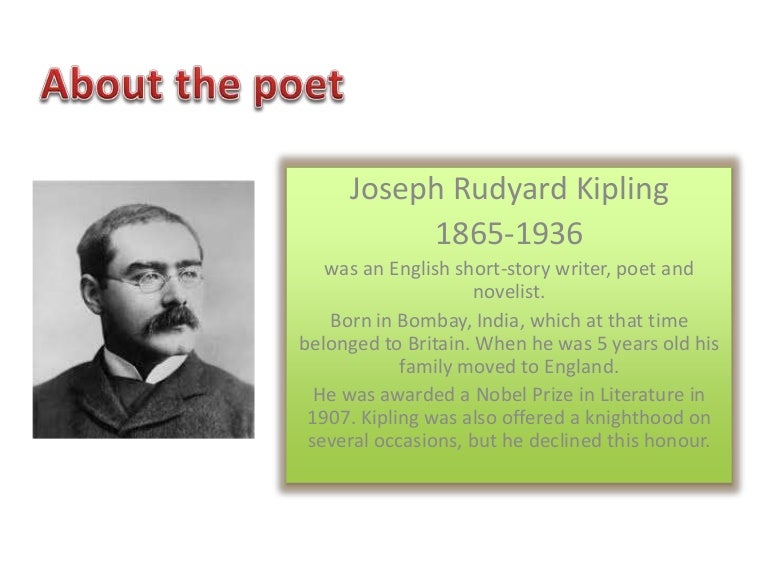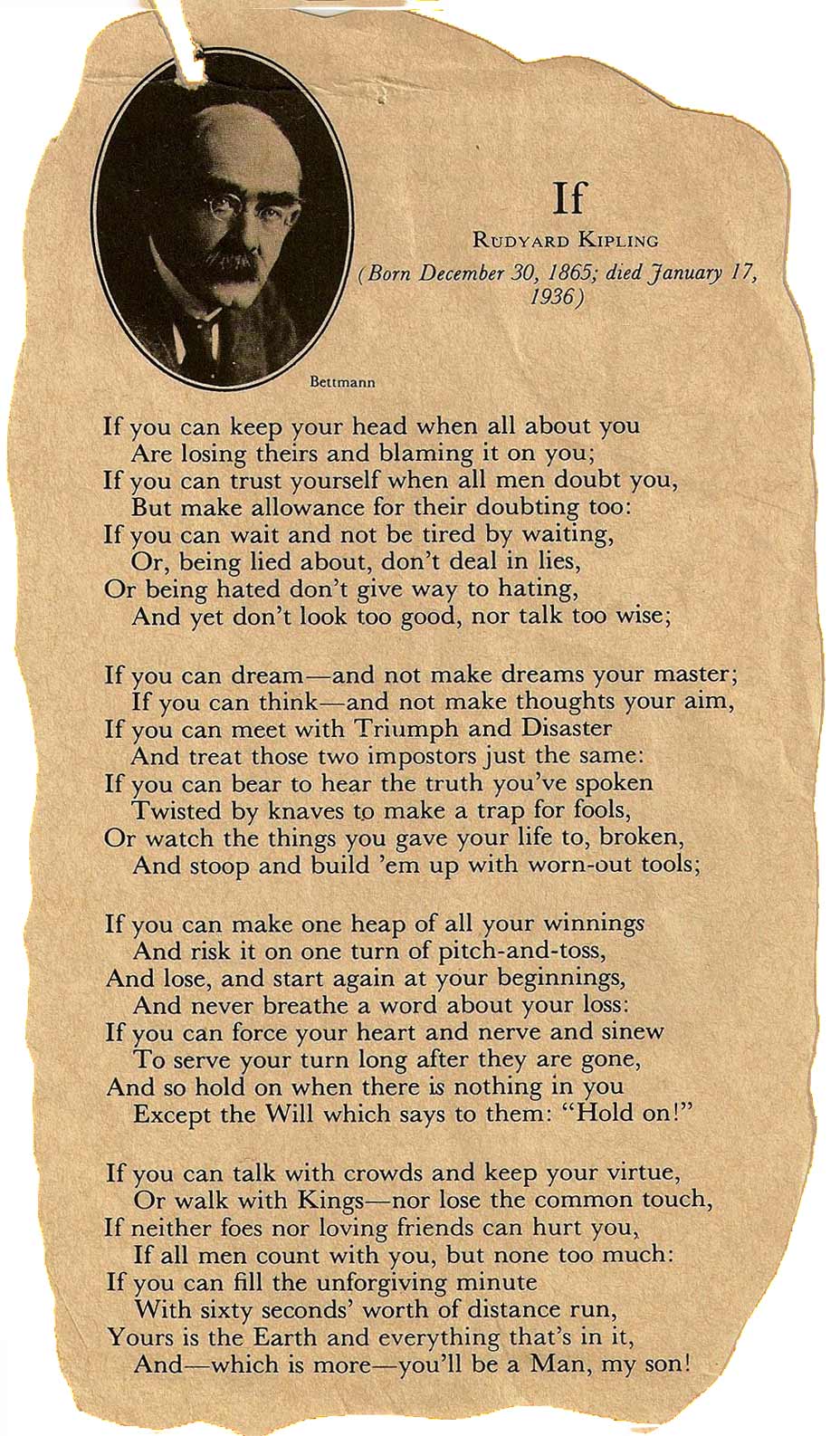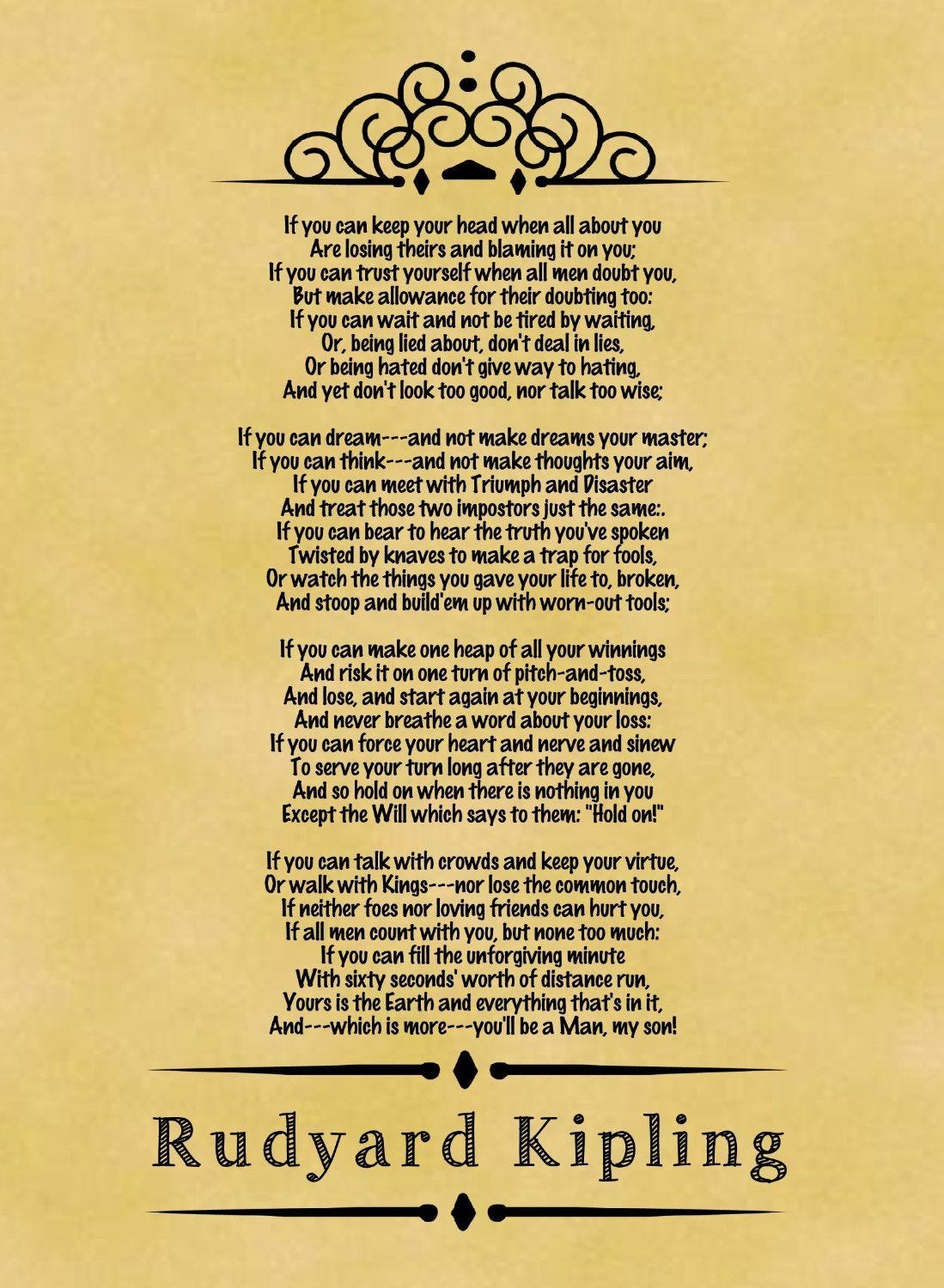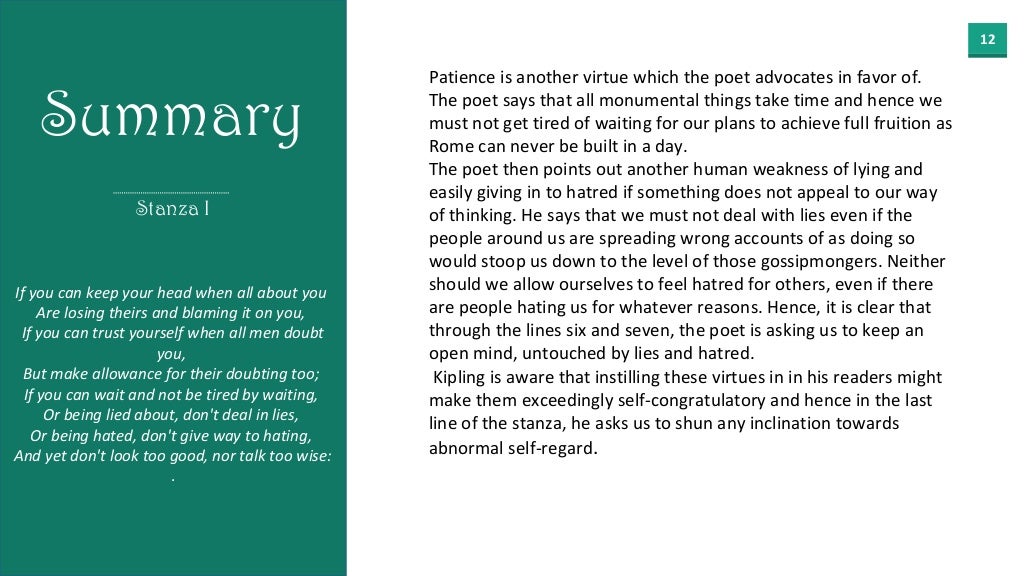If By Rudyard Kipling Analysis Questions slidesharedocs

If By Rudyard Kipling Analysis Questions slidesharedocs
Dr. Jameson (1809); Internet Archive Book Images, No restrictions, via Wikimedia Commons An In-Depth If— by Rudyard Kipling Analysis. If— by Rudyard Kipling is a poem that makes use of a specific structure that is quite individual to this poem. It uses a four-stanza structure in which every stanza makes use of eight lines, and each of those lines has the same length.

Explanation of the poem "If—" by Rudyard Kipling, Part 2 YouTube
The virtues expressed in "If-" are devoid of showiness or glamour; it is notable that Kipling says nothing of heroic deeds or great wealth or fame. For him the true measure of a man is his humility and his stoicism. Kipling's biographer, Andrew Lycett, considers the poem one of the writer's finest and notes in 2009 that "If-" is absolutely.

if by Rudyard Kipling analysis What is the purpose of the poem “If
If you can keep your head when all about you Are losing theirs and blaming it on you, If you can trust yourself when all men doubt you, But make allowance for their doubting too; If you can wait.

Analysis of If by Rudyard Kipling
The Jameson Raid of 1895. Although he didn't publish it until 1910, Kipling originally wrote "If—" in 1896, after learning about a British military endeavor that had failed the previous year in South Africa. The so-called "Jameson Raid" was a mercenary operation that played a role in a larger, unauthorized attempt on the part of the.

If by Rudyard Kipling Analysis Best Motivational Poem
Contents. The poem "If" is a masterpiece written by a British Poet Rudyard Kipling in 1895. It was first published in 1910 in the chapter "Brother Square Toes" of the book "Rewards and Fairies" which is a collection of Rudyard Kipling's poetry and short-story fiction. The poem is an inspirational one written in second-person.

If Rudyard Kipling Poem Analysis SchoolWorkHelper
The poet conveys his ideas about how to win this life, and after all, how to be a good human being. The poem, written in 1895 and first published in 'Rewards and Fairies', 1910 is 32 lines long with four stanzas of eight lines each. It is a tribute to Leander Starr Jameson. The poem is written in the form of paternal advice to the poet's.

Analysis of If by Rudyard Kipling YouTube
"If" by Rudyard Kipling Analysis Summary of the Poem, "If" Introduction of "If" by Rudyard Kipling: "If" by Rudyard Kipling, a famous essayist and poet is a suggestive poetic piece. Kipling wrote this poem to pay tribute to his friend, Leander Starr Jameson. Although the poem was written in 1895, it was printed in 1910.

If Poem by Rudyard Kipling Summary YouTube
Rudyard Kipling Biography Owl Eyes is an improved reading and annotating experience for classrooms, book clubs, and literature lovers. Find full texts with expert analysis in our extensive library.

Rudyard Kipling's "If" Analysis Timeless Gems of Masculine Wisdom
1936. If you can keep your head when all about you. Are losing theirs and blaming it on you; If you can trust yourself when all men doubt you, But make allowance for their doubting too; If you can wait and not be tired by waiting, Or, being lied about, don't deal in lies, Or, being hated, don't give way to hating,

IF by Rudyard Kipling Summary and Analysis YouTube
A summary of Themes in Rudyard Kipling's If—.. SparkNotes Plus subscription is $4.99/month or $24.99/year as selected above. The free trial period is the first 7 days of your subscription.

If by Rudyard Kipling. Summary of “If” by The Sparklin’ Horcrux Medium
Rudyard Kipling, one of the most famous poets of the late British Empire, published "If—" in his 1910 book Rewards and Fairies. The poem's speaker advises his son to live with restraint, moderation, and composure. The son should always keep his wits about him, the speaker says, never overreacting; he should learn to be confident without being.

'IF —' by Rudyard Kipling Summary & Analysis Englicist in 2021 If
This poem by Rudyard Kipling is a notable example of 20th-century poetry, which saw a shift towards more introspective and reflective themes. Kipling's poem reflects the changing societal and cultural landscape of the time, providing guidance and moral direction to individuals in a rapidly evolving world.

IF by Rudyard Kipling Detailed Summary and Analysis
Thanks for exploring this SuperSummary Study Guide of "If—" by Rudyard Kipling. A modern alternative to SparkNotes and CliffsNotes, SuperSummary offers high-quality Study Guides with detailed chapter summaries and analysis of major themes, characters, and more.

IF by Rudyard Kipling Detailed Summary and Analysis
By Rudyard Kipling. ('Brother Square-Toes' —Rewards and Fairies) If you can keep your head when all about you. Are losing theirs and blaming it on you, If you can trust yourself when all men doubt you, But make allowance for their doubting too; If you can wait and not be tired by waiting, Or being lied about, don't deal in lies,

If By Rudyard Kipling Picture Investmentpedia
1910 (114 years ago) ( 1910) " If— " is a poem by English poet Rudyard Kipling (1865-1936), written circa 1895 [1] as a tribute to Leander Starr Jameson. It is a literary example of Victorian-era stoicism. [2] The poem, first published in Rewards and Fairies (1910) following the story "Brother Square-Toes", is written in the form of.

IF by Rudyard Kipling Detailed Summary and Analysis
Rudyard Kipling's "If—," written in 1895 and published in Rewards and Fairies (1910), is a historical fantasy book consisting of a series of short stories, each preceded and followed by a poem. "If—" is a didactic poem that provides inspiration and guidance on the ideal behavior to be a better person. It underscores the virtuous.